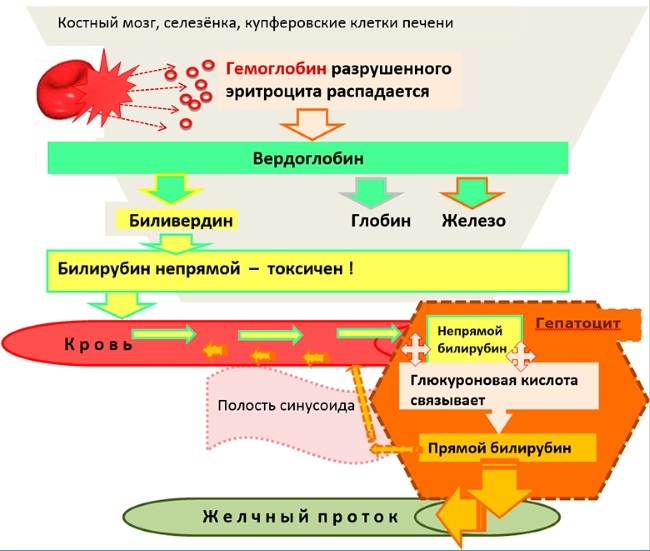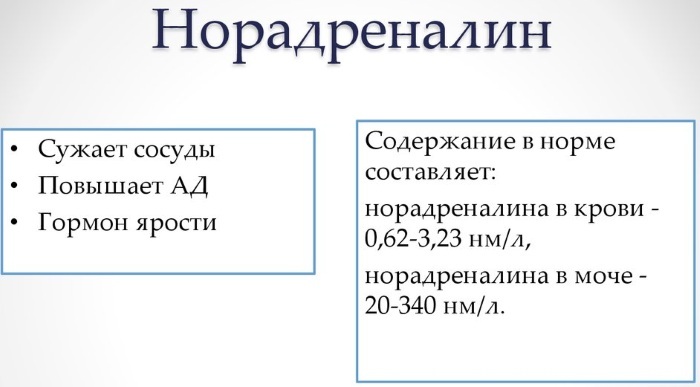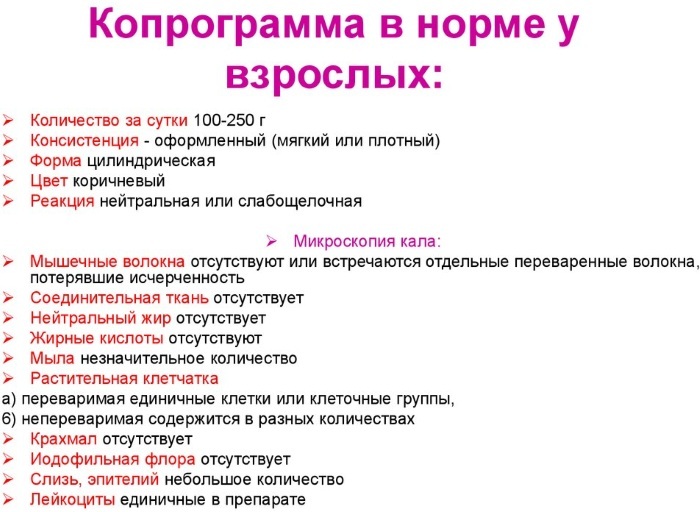Often with a comprehensive examination of patients doctors prescribe a biochemical blood test. It includes the definition of the Urea level. To understand the diagnostic value of this indicator, it is necessary to clearly understand the main stages of its formation.
Record content:
- 1 What is urea
- 2 The value and function of urea in the body
-
3 The rate of urea in the blood
- 3.1 Among women
- 3.2 In men
- 3.3 In children
- 4 Reduced level
- 5 Elevated level
- 6 Influencing factors
- 7 Reactions and methods for the determination of urea
- 8 How to get tested correctly
- 9 Blood test videos
What is urea
In the process of digesting proteins, peptide chains break down into amino acids. As a result of their deamination (detachment of the amino group from the amino acid molecule) and further biochemical transformation, ammonia is formed in the body. It is a toxic product of nitrogen metabolism, which has a detrimental effect on organs, primarily on the nervous system.
In tissues, ammonia binds with glutamic acid to form glutamine, a harmless transport compound that easily passes through cell membranes. In this form, the nitrogenous compound is delivered to the liver. Here it is detoxified and converted into non-toxic urea.
This process begins in the mitochondria and continues in the cytoplasm of liver cells with the participation of a number of enzymes and amino acids. The formed urea from hepatocytes is transported into the blood, then excreted by the kidneys.
One or another amount of urea is constantly present in the blood.
The change in its level depends on:
- from the amount of protein consumed with food;
- on the intensity of the breakdown of the body's own proteins;
- on the functional state of the liver and the possibilities of its enzyme systems;
- from the excretory ability of the kidneys.
The value and function of urea in the body
Urea is a neutral, non-toxic, water-soluble substance, the end product of protein metabolism. It is synthesized as a result of the metabolism of amino acids in order to neutralize ammonia.
Does not perform independent functions in the body. In fact, it is a transport form for spent toxic components that are not needed by the body. Excretion is carried out by the kidneys in the urine.
An increase in protein content in food or an increase in the breakdown of tissues' own proteins is accompanied by a change in the rate of urea formation. Thus, nitrogen equilibrium is maintained.
The rate of urea in the blood
Urea in the biochemical analysis of blood of healthy people varies depending on age and gender.
So, the younger the child, the lower his normal values of this indicator. This is due to the increased consumption of protein for the needs of the growing body. In newborns, physiological hyperazotemia may be observed, which is an increase in nitrogenous products in the blood due to increased protein catabolism and insufficient fluid intake.
Women tend to have lower urea levels than men. In pregnant women at a later date, the urea content decreases as a result of the activation of protein synthesis for building tissues of the growing fetus, as well as due to physiological overhydration.
With age, the concentration of urea increases due to a decrease in the activity of anabolic processes and the functional ability of the kidneys for excretion.
Urea in a biochemical blood test is measured by the number of millimoles of a substance per liter. 1 mol = 1000 millimoles.
Among women
For women, the norms are:

| Age indicator (years) | Urea (mmol / l) |
| 17-21 | 2,8-7,6 |
| 21-51 | 2,5-6,7 |
| Older than 51 | 3,6-7,3 |
| During pregnancy up to 19 weeks | 2,9-7,3 |
| During pregnancy at 19-40 weeks | 1,5-4,6 |
In men
For men, the following standard indicators have been established:
| Age category (in years) | Indicators (mmol / l) |
| 18-20 | 2,9-7,5 |
| 20-50 | 3,2-7,3 |
| Over 50 | 3,0-9,2 |
In children
Children's indicators differ significantly:
| Age group (years) | Rate (mmol / l) |
| Full-term newborns | 1,4-4,3 |
| Newborn premature | 1,1-8,9 |
| Up to 1 | 1,4-5,4 |
| 1-4 | 1,8-6,0 |
| 4-15 | 2,5-6,7 |
| 15-18 | 2,9-7,5 |
Reduced level
Urea may have low values when tested as part of a biochemical blood test. This is due to both physiological factors and diseases.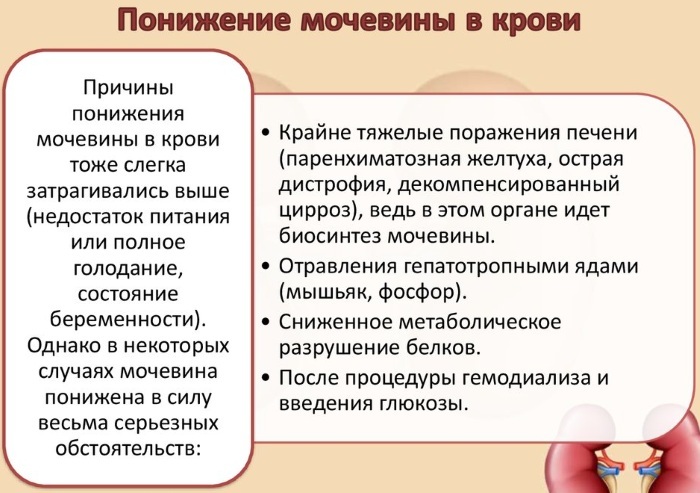
Reasons for low rates in adults and children:
- Insufficient protein in food.
- Pregnancy.
- Intensive use of proteins due to rapid growth, increase in muscle mass, intake of anabolic steroids.
- Overdose of drugs that affect the activity of liver enzymes.
- With the abuse of diuretics.
- The synthesis of urea decreases with acidosis, since part of the ammonia is consumed for neutralization with the formation of ammonium salts.
Possible diseases:
- Diseases of the stomach with impaired secretion of proteolytic enzymes (anacid gastritis, atrophic gastritis, tumor, peptic ulcer).
- Diseases of the small intestine, with impaired resorption (enteritis, duodenitis, tumor, peptic ulcer, celiac disease).
- Diseases of the liver in violation of its neutralizing function (hepatitis, cirrhosis, acute liver dystrophy, tumors, hepatic coma).
- poisoning with hepatotoxic poisons (alcohol, organophosphorus substances, arsenic).
- Kidney disease, accompanied by an increase in the excretion of protein in the urine and a decrease in its content in the blood (nephrotic syndrome).
- Endocrine diseases (acromegaly, increased formation of antidiuretic hormone).
- Congenital fermentopathies.
The clinical manifestations of a decrease in the concentration of urea, as a rule, depend on the underlying disease. If this is due to a decrease in the intake, digestion or absorption of protein, then the signs of protein starvation come to the fore.
Diseases of the stomach and intestines are manifested by a characteristic pain syndrome, dyspepsia. Patients may have nausea, a feeling of fullness in the stomach, belching, unstable stools, and aversion to meat foods.
Liver lesions are accompanied by bursting pains in the right hypochondrium, enlarged liver, bitterness in the mouth, vomiting of bile, yellowness of the skin and mucous membranes, unstable stools may be noted.
As a result of a decrease in the detoxifying ability of the liver, the ammonia content in the blood increases. Due to its toxic effect on brain cells, hepatic coma can develop.
With acromegaly, there is a disproportionate increase in some parts of the body: the upper or lower jaw, limbs.
Congenital fermentopathies practically from the first days of a child's life lead to an increase in the blood level of ammonia and intermediate products of nitrogen metabolism - citrulline, argininosuccinate, arginine. They appear in the urine, while the concentration of urea in the urine is reduced.
The severity of hyperammonemia is in direct proportion to the decrease in the activity of enzymes. In severe cases, the outcome can be fatal. In the lungs, due to toxic brain damage, the child lags behind in intellectual development, frequent and prolonged headaches are noted.
Congenital pathology is diagnosed by the presence of ammonia and intermediate products of its metabolism in the blood and urine against the background of a decrease in urea. A decrease in the activity of enzymes in the liver is also found.
If low urea is associated with a particular diet, adjustments are made. If a decrease in the concentration of urea is a manifestation of the disease, then after a complex of laboratory and diagnostic studies, adequate therapy is prescribed.
In congenital fermentopathies, protein intake is limited as much as possible. This reduces the extent of damage to brain cells.
Elevated level
Urea in a biochemical blood test may be elevated. A number of factors contribute to this.


Reasons for high rates in adults and children:
- An increase in the diet of foods rich in protein (meat, legumes, protein food for athletes).
- Taking certain medications (antibiotics, sulfa drugs, corticosteroids).
- Heavy physical activity.
Possible diseases:
- Renal failure
- Decreased outflow of urine as a result of obstruction of the urinary tract with a stone or tumor.
- Acute or chronic inflammation of the kidneys (glomerulonephritis, pyelonephritis).
- Cardiovascular pathology, accompanied by impaired blood supply to the kidneys.
- Diseases accompanied by dehydration (infections with indomitable vomiting, diarrhea, high fever).
- Diseases accompanied by an increase in the breakdown of their own tissue proteins:
- hematological (leukemia with high leukocytosis, hemolytic and megaloblastic anemias);
- endocrine (hyperthyroidism, diabetes mellitus with ketoacidosis);
- bowel disease with tissue necrosis (peritonitis, thrombosis, obstruction);
- destructive diseases and damage to the skin and soft tissues (extensive phlegmon, gangrene, burns, frostbite, prolonged compression syndrome);
- gastrointestinal bleeding;
- malignant tumors with decay.
An increase in the concentration of urea (uremia), as a rule, is a manifestation of the above diseases. In practice, most often it is kidney damage. Patients complain of pain in the lumbar region, weakness, dizziness, headache, nausea, vomiting, a decrease in the amount of urine (oliguria) up to its complete absence (anuria).
There may be polyuria (an increase in the amount of urine excreted), frequent and painful urination. Examination reveals swelling of the eyelids, hands, pasty face, increased blood pressure.
With heart failure, there is shortness of breath, cyanosis and swelling of the legs, heart rhythm disturbances, pain in the region of the heart.
An increase in urea is a sign of diabetic nephropathy. The patient should urgently consult an endocrinologist in order to correct the treatment.
If urea rises as a result of inaccuracies in the diet, it is necessary to reduce the amount of meat products in the diet, eat more vegetables, fruits, cereals, juices. Good results are obtained with rosehip decoction, fruit teas.
If an increase in urea is associated with a disease, treatment is prescribed exclusively by a doctor. Self-medication is unacceptable in any case. Therapy is aimed at curing the underlying disease, restoring kidney function, reducing intoxication and removing nitrogenous compounds from the body.
Sorbents (Polysorb, Atoxil, Enterosgel, Siliks) are used to bind and remove nitrogenous components. In severe cases, hemodialysis (artificial kidney) is the option of choice. In the absence of qualified treatment, the development of uremic coma and death is possible.
Influencing factors
- When the diet contains a large amount of protein (meat, fish and seafood, milk and dairy products, legumes), the level of urea in the blood increases slightly. With the predominance of plant foods (vegetables, fruits, grains), it decreases.
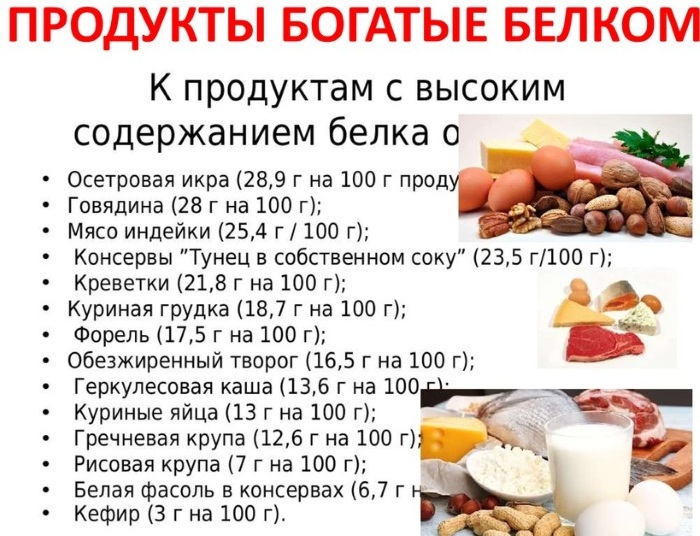
- Excessive fluid intake is accompanied by a decrease in the concentration of substances dissolved in the blood, including urea. With a small intake of fluid in the body, some blood thickening occurs, and therefore a slight increase in urea.
- Obesity does not affect the urea content. However, it can be a manifestation of metabolic pathology (for example, in diabetes mellitus, metabolic syndrome) and be accompanied by impaired protein metabolism and renal function.
Reactions and methods for the determination of urea
Several methods have been proposed for determining the concentration of urea in biological fluids:
- Gasometric method. As a result of chemical transformations, urea decomposes into several components, one of which is carbon dioxide. Its volume is used to judge the level of urea in the sample.
- Colorimetric method with diacetyl monooxime. In an acidic environment, when reagents are added, a colored substance is formed from urea. The intensity of its color corresponds to the content of urea. Optical density is measured on a photometer, and the concentration of urea is determined from it.
- Enzymatic (urease) colorimetric end point method. The substance that triggers the reaction is placed in the sample. After a strictly defined time, she is stopped. By the content of the formed colored reaction product, the concentration of urea in the sample is judged. The higher the urea level, the brighter the color. Optical density is measured with a photometer.
- Enzymatic (urease) kinetic method. An enzyme that catalyzes the urea conversion reaction is added to the sample. The rate of oxidation of NADH, determined photometrically, is used to judge the urea in the sample.
When performing the KLA, hematological parameters and the cellular composition of the blood are determined. Urea is a biochemical parameter. It is not included in the list of indicators of general analysis.
How to get tested correctly
In order for the result of "biochemistry" to be informative, certain rules must be followed. Blood for research is donated in the morning on an empty stomach, no earlier than 8 hours after the last meal in the usual water regime.
The day before the analysis, alcohol, heavy physical activity, visits to the sauna, steam room are excluded. It is recommended to exclude smoking, physical and emotional stress for 2 hours. Physiotherapy, massage, X-ray and ultrasound are not allowed before donating blood.
Urea in a biochemical blood test is determined in combination with other indicators during a comprehensive examination for diagnostic purposes or during a preventive examination. This is the most common survey method.
It allows you to judge the main metabolic processes of protein, carbohydrate, lipid, mineral types of metabolism, as well as assess the functionality of organs.
If deviations of the obtained research results from normal values are detected, it is necessary to find out its cause.
For this purpose, several more biochemical parameters are determined:
- Residual nitrogen Is nitrogen contained in protein breakdown products. 50% of them are urea, 25% are individual amino acids, 5% are creatine and creatinine, 4% is uric acid, the rest is ammonia, indican, peptides. Usually, either residual nitrogen or urea is determined, since both indicators indicate the same changes.
- Creatine - enters the body as part of meat food or is formed endogenously in the liver and kidneys. Its function is energetic. Combining with the remainder of phosphoric acid, it forms creatine phosphate, which is a source of energy for muscle contractions. In laboratory practice, it is rarely determined.
-
Creatinine - a derivative of creatine. It is completely filtered by the glomerular apparatus of the nephrons and is absolutely not absorbed in the kidney tubules. This makes it convenient for assessing the filtration capacity of the kidneys. Along with urea, it is an indicator of uremia.
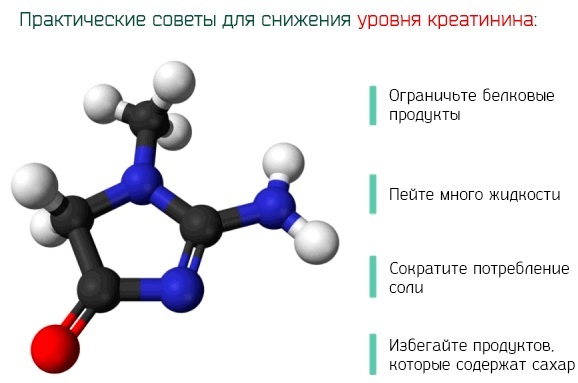
- Total protein Is the total amount of serum proteins (albumin and globulins). This indicator is used to judge the state of protein metabolism as a whole.
- Bilirubin - a toxic substance formed from hemoglobin. By binding to the plasma protein albumin, it enters the liver. If the level of albumin in the blood is low, the delivery of bilirubin to hepatocytes is disrupted, it accumulates in the blood and tissues. For example, in newborns with hypoalbuminemia, physiological jaundice is observed, which disappears when the synthesis of albumin is normalized. Liver cells absorb free (indirect) bilirubin from the blood. Here it binds to glucuronic acid, passing into a soluble state. It is linked (direct) bilirubin. As part of bile, it is excreted into the intestines. Bilirubin, especially its indirect fraction, is used to judge the functional state of the liver.
If deviations of urea from normal values are found, before proceeding with treatment with folk remedies, it is necessary to consult a doctor. Only after a complete examination will he be able to give appropriate recommendations. Folk remedies are not always harmless.
So, with renal failure, diuretic herbs are contraindicated. Self-medication with decoctions and tinctures of medicinal herbs at best can be useless, at worst - harm your health.
The Urea study is essential in the diagnosis of a variety of diseases. Therefore, this indicator is mandatory when conducting a biochemical blood test.
Blood test videos
Deciphering a biochemical blood test:

